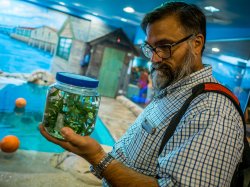Studying Power Plant’s Effects on Barnegat Bay Estuary

The Oyster Creek Nuclear Generating Station in Lacey, New Jersey, was the nation’s oldest active nuclear power plant when it was powered down last fall, giving a team of Montclair State researchers a unique opportunity to assess the station’s impact on the Barnegat Bay Estuary.
Biology professors Paul Bologna, John Gaynor and Robert Meredith have received $131,934 in grants from the New Jersey Department of Environmental Protection for the first two years of a three-year project to study the profound impact they believe the station has had on the community structure of jellyfish in Barnegat Bay.
“This is a truly once-in-a-lifetime opportunity for us to collect incredible data before and after the decommissioning of a nuclear power plant,” says Bologna. “It’s highly likely that the combined research and efforts will generate information relevant to many different power and industrial plants.” For Meredith, the project also offers an unprecedented opportunity to conduct “a mini experiment of global climate change and its potential impact.”
In the summer of 2018, Bologna and a team of undergraduate and graduate students collected, processed, identified and measured samples in the field. The organisms will be compared to those collected after the plant’s shutdown. Gaynor and Meredith are using DNA analysis to identify any unknown organisms collected by Bologna and his students. Their efforts, according to Bologna, will essentially “bar code” the bay.
The professors will determine the impact of the plant on the bay by discovering — and pinpointing — differences between the types of organisms collected before and after the shutdown. They expect to see an impact on everything from crabs and eelgrass to larval fish and jellyfish and have hopes that the area will return to what it was like before the plant opened in 1969. “How long this might take, though, is anyone’s guess,” Meredith says.
